The study of the properties of nanomaterials. Рубрика в журнале - Nanotechnologies in Construction: A Scientific Internet-Journal
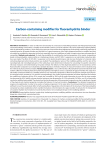
Carbon-containing modifier for fluoranhydrite binder
Статья научная
Introduction. In order to widen the functionality of construction and building materials and widespread electrically conductive building constructions, it is highly recommended to reduce cost of the solutions. This can be achieved by replacing binders with the industrial by-products. At the same time, there are a few articles about adjustment of electrically conductive properties of materials based on by-product binders and this field is of a great importance. Also, highly dispersed particles in modifiers and their role might be considered as important to find out, especially when such additives are used to improve structure and properties of composites. Methods and materials. To study the possibility of controlling the electrical properties of the matrix, compositions based on fluoroanhydrite, sodium sulfate as a hardening activator, and UPC-MIX-1 suspension as an electrically conductive additive, were made. The effect of UPC-MIX-1 suspension on the electrical performance and structure formation of a mineral matrix containing dispersed carbon black particles was studied. The polydisperse nature of the modifying additive and the ratio of the nanodispersed and microdispersed parts of the solid phase were determined. Indicators for calculating the specific volumetric electrical resistance were determined by the probe method. The influence of the dispersed additive on the characteristics of the fluoroanhydrite composite was evaluated by standard laboratory methods. Features of structure formation were evaluated using the methods of physicochemical analysis. Results and discussion. It was confirmed that a fluoranhydrite-based mineral binder with sodium sulfate has moderate physical mechanical properties and might be used as a substitute for gypsum binder. The usage of an electrically conductive additive as a modifier enhances such mechanical properties as flexural compressive strength and compressive strength which increase by 51% and 65% correspondingly. Also, hydro physical properties have been improved, for instance the coefficient of softening for the FD-4 sample has increased by 39%, and the water absorption by mass for the same sample has decreased by 36%. Specific volume electrical resistance has decreased by 49–52% and equals13,6 kOm • cm, 8% of electrically conductive additive being added. The physical and technical properties of the presented composite are due to significant changes of the physical and chemical properties including the features of structure formation. Conclusions. The obtained compositions require extra optimization in order to be used as a heating component. At the same time, the achieved electrical conductivity is sufficient to level the electrostatic effect of self-leveling floors. Regularities in the formation of the structure of the fluoroanhydrite composite have been established, which manifest themselves in the formation of a larger number of contacts for the intergrowth of crystalline hydrate new formations ensured by the presence of a nanodispersed part in the modifying additive.
Бесплатно
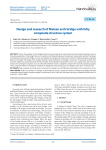
Design and research of Nielsen arch bridge with fully composite structure system
Статья научная
China is the kingdom of arch bridges. Based on the principle of structural elastic potential energy standing value, the innovative application of the design theory of composite arch bridge bending and compression is presented, optimize the design of composite structural arch bridge arch axis, and propose the design and construction method of medium-bearing composite Nielsen arch bridge. The design of the medium-bearing composite Nielsen arch bridge is carried out, its structural strength, stiffness and stability are analyzed by finite element analysis. By simulating the parameters of arch axis, sagittal span ratio and arch section, the convergent composite arch axis with solid web foot section is adopted to improve the economic spanning capacity of the composite Nielsen arch bridge and expand the adaptation range of large span arch bridge in plain area or soft base area.
Бесплатно
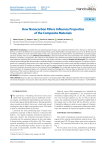
How Nanocarbon Fillers Influence Properties of the Composite Materials
Статья научная
Introduction. Currently the most promising type of repair uses composite materials to fill in fractures or fracture-like defects. In order to be effective, the composite material must possess high fluidity in its liquid state to ensure it can fill the cavity of the defect, adhesion to steel to bond the edges of the crack, and plasticity to compensate for any deformation caused by regular and static loading of the structure. Methods and materials. Composite materials with nanocarbon fillers were studied, including fullerenes, nanotubes, and graphene. The solutions to the problems were obtained using both standard and independently developed methods, statistical data processing techniques, and modern software complexes. Results and discussion. The composite material with a fullerene filler demonstrates a sustainable fluidity in comparison to other studied composites. This allows to recommend such a material for fixing cracks with a slight opening. The composite with a carbon nano tube filler maintains the fluidity at the same level within 35 minutes on average. It can be used as a repair material in cases where the location of the defect does not allow for its sealing to be carried out in a short period of time. Conclusion. The conducted research allows to solve the direct and inverse problem: a) studying properties of a composite material and designing its structure allow to determine, if it fit to certain dimensions of the crack; b) a detected crack with a certain configuration of the cavity can be offered the most suitable properties of the composite by adjusting its content.
Бесплатно
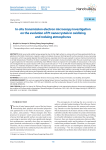
Статья научная
Metal nanocrystals exhibit unique properties due to their high surface-to-volume ratio and have great potential for applications in the fields of electronics, magnetics, optics and catalysis. However, their high specific surface area leads to easy coarsening in operation, which may greatly degrade their performances, especially when they are exposed to various chemical environments or at high temperatures. Therefore, the direct visualization of nanocrystals' structural evolution when they are coarsening is crucial to gain insight into the mechanism and develop more effective means to improve the size stability of nanocrystals. In this work, we investigated the structural evolution of Pt nanocrystals with sizes of ~ 4 nm on SiNx film in both oxidizing and reducing atmospheres at a moderate temperature (300оС) in the aberration-corrected environmental transmission electron microscopy (ETEM). The sizes of nanocrystals remain almost unchanged when annealed in the oxygen atmosphere with volatile PtOx formation on the surface, hindering nanocrystals sintering and leading to Pt loss. On the other hand, obvious coarsening of nanocrystals resulting from Ostwald-ripening and nanocrystal migration and coalescence was observed in the reducing atmosphere. Our findings reveal the dynamic structural evolution of nanocrystals in different atmospheres and provide possible ways to improve the size stability of nanocrystals.
Бесплатно
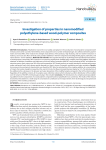
Investigation of properties in nanomodified polyethylene-based wood-polymer composites
Статья научная
Introduction. Polyethylene is by far the most widely used polymer in the production of wood-polymer composites both in Russia and in other countries. Nevertheless, these composites have a number of disadvantages: low adhesion between polymer matrix and wood filler, which reduces the strength characteristics of the products, high elasticity, and low weather resistance. In industry, such issues are often solved by using complex additives in the form of granules including binding agents, lubricants, and various thermo- and UV-stabilizers. Methods and materials. New experimental data on technological and operational characteristics of wood-polymer composites (WPC) based on low-pressure polyethylene modified with complex processing additive have been obtained. In addition to stabilizers and lubricants, multi-wall carbon nanotubes (MWCNT) were introduced in WPC to facilitate the extrusion process, their content was 30% of the total composition. WPC-based products are mainly intended for outdoor performance under mechanical load, which places special demands on them in terms of strength, weathering and water resistance. Results. An increase in the mechanical characteristics was found for WPC after the introduction of the complex additive: at a concentration of 2.6 phr, the tensile strength increased by 35%, and at 53.3 phr, the flexural strength became higher by 12%. The introduction of the additive led to a decrease in the abrasion and water absorption of the modified sample compared to that of the initial material. Regardless of the additive content, all the samples were uniformly colored, which indicated a uniform distribution of the modifier over the volume of the WPC melt during processing in the extruder. Conclusion. The introduction of a complex processing stabilizing additive into the composition of a wood-polymer composite based on polyethylene was carried out. The results of the research showed that the additive in a wide range of concentrations contributes to the improvement of the technological and operational properties of the resulting composites.
Бесплатно
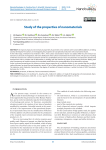
Study of the properties of nanomaterials
Статья научная
To improve physical and mechanical properties of pavements new materials with nanomodified additives are being actively developed. The authors are investigating the properties of road petroleum bitumen with nanomaterial Taunit. At the initial stage, oil bitumen was heated to 100о C. Then carbon nanomaterial «Taunit» was added. After that, the mixture was stirred in an ultrasonic homogenizer until even distribution of the carbon nanomaterial in the total volume. The process of cooling of the final structure was carried out until the end of the crystallization process. Then, the specimens are exposed to tension and strength tests with a constant rate of deformation or loading until the moment of rupture on the testing machines. Mixing with other components of asphalt concrete in the standard mode follows the nanomodification of the bituminous mixture. Under increased temperatures the bitumen mixture keeps properties of an effective binder. It was revealed that the modified carbon bitumen has good thermal properties, namely, it has a higher softening temperature (Δt is in the range from 6 to 10ºС). The indicator, which indirectly characterizes the degree of hardness of bitumen solutions, is within the limits of GOST standards, decreases by 15–20%.
Бесплатно
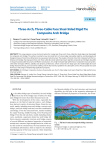
Three-Arch, Three-Cable Face Steel-Sided Rigid Tie Composite Arch Bridge
Статья научная
This essay proposes a new structural system for a large span three-arch, three-cable face steel edge main beamrigid tie composite arch bridge. The authors invented a new structural form of a steel edge main girder rigid tie, and developed and designed a key arch-bar three-dimensional six-way space node structure. The analysis of results show that: compared with the traditional arch bridge, the large span three-arch three-cable face steel-sided main beam rigid ties composite arch bridgeis beautiful in shape, hasareasonable structure and efficient construction. It is a high-strength, high-performance composite structural system, with better strength, stiffness, stability and dynamic performance, which overcomes the large span ultra-wide bridge deck arch bridge horizontal thrust, poor transverse stability, and the key technical problems of acable joint control. The proposed structural form has a wide range of engineering application prospects.
Бесплатно
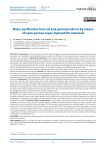
Water purification from oil and petrol products by means of nano-porous super-hydrophilic materials
Статья научная
Introduction. This article reveals the research results of physical and chemical properties of the new filtering material, evaluation of its hydrophilic and oleophobic features as well as the efficiency of oil-in-water emulsions separation in laboratory conditions and in production. Methods and materials. As the base for creation of new filtering material a natural mixture of minerals with good prevalence of silicon earth also including some small amounts of fissile hydrous silicates (mica, clay) was chosen, which provide the durability of granulated end product at reservation of porosity and hydrophilic properties of the material surface. The research used spherical shape granules of various particle size obtained by drying, granulation and firing. Prior to filtration the granules are being impregnated with water aiming to obtain a water shell around each granule, which provides granules protection from oil and petrol products contamination as well as an easy filter cleaning by backwashing in fluidization mode. For the lab testing of oil-in-water emulsions separation parameters a test rig was built. In process a set of various tool methods of physical and chemical research was used. Results. The chemical and mineral composition of the developed filtering material and the results of its X-ray-structural analysis, photomicrography of ground substrate obtained with SEM are given as well as the porous structure data (pores size distribution and aggregate pores of granules material) obtained by the method of low-temperature nitrogen adsorption. The results of laboratory and pilot testing of separating and accumulating ability of the filtering material are presented. Interpretation. The obtained data prove the fact that the developed material possesses over the prominent hydrophilic properties, while after water shell creation also over the oleophobic properties. Upon exploration of the two liquid immiscible phases separation during the filtering through the granules obtained, a significant efficiency growth of the filter after attaining the special amount of oil and petrol products retained by the filter was detected. The efficiency increase of the filter is connected with formation of a prolonged structure, which was named by the authors a “fluid net”, created by the oil and petrol products entrapped. The strings of that “fluid net” being formed in the gaps between the granules are decreasing the sizes of the passages which lets the entrapping efficiency of finer oil and petrol products droplets grow. Conclusion. The obtained nano-porous granules of the filtering material exhibit super-hydrophilic properties and based on the water shell created around them provide the following: protection of granules from contamination with oil and petrol products contained in water to be purified; effective and not decreasing over the course of time filter regeneration by means of backwashing in fluidization mode; quality of water purification from oil and petrol products at the level of the most expensive purification methods. Prospective fields of applications. The “OreFilter” technology developed has passed the pilot scale validation on the basis of more than fifty industrial objects of different industrial branches (mainly on those connected with oil production and oil refining) in Russia and abroad. The technology is now being tested on industrial objects in the Near East, Canada, US, Brazil and Australia. The industrial filtering units using “OreFilter” technology are already in operation on Russian enterprises as well as in Sweden and Germany. The experimental-industrial tests have proved the application efficiency of the technology developed: in food industry; at the detergents and soaps manufacturing plants; at mining and processing plants; at purification of ballast and bilge water at ports; at purification of polluted water after oil tankers washing; in fish farming; in seaquariums and dolphinariums.
Бесплатно

